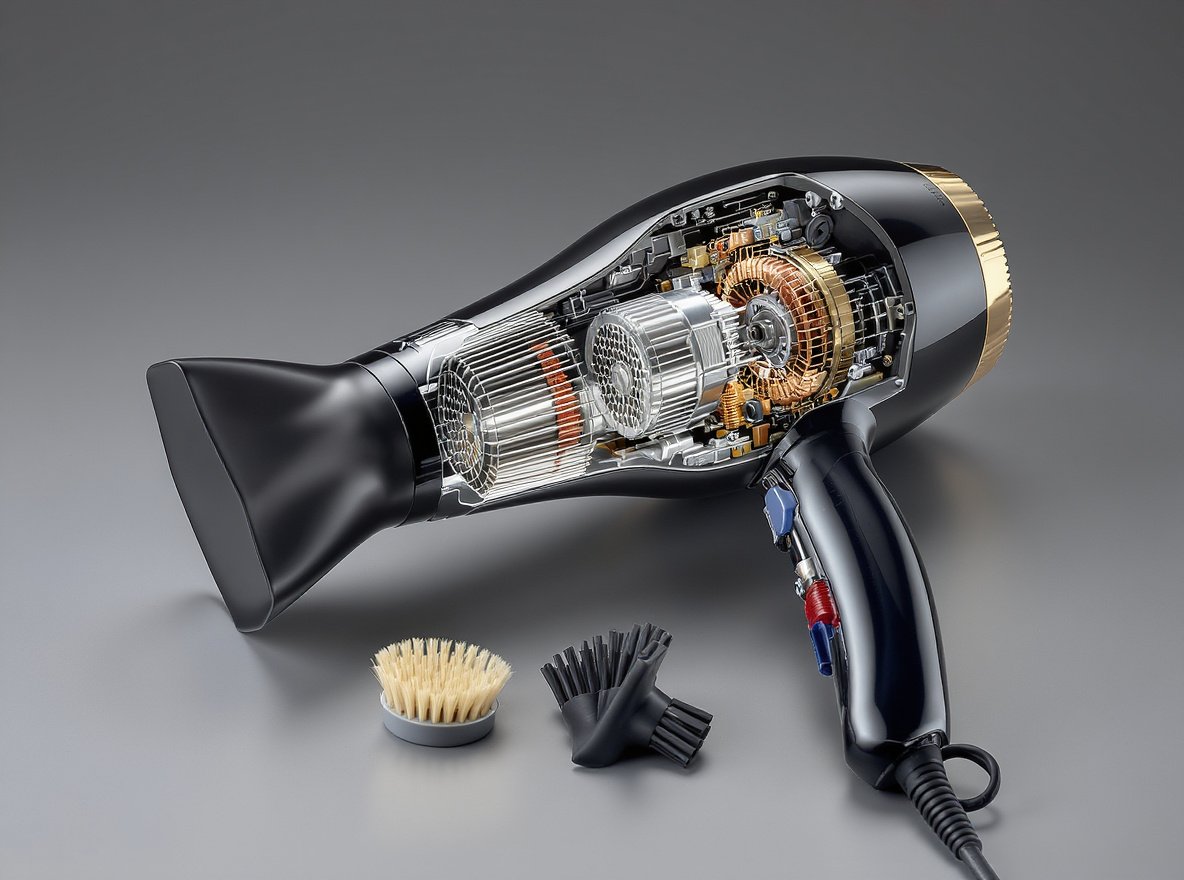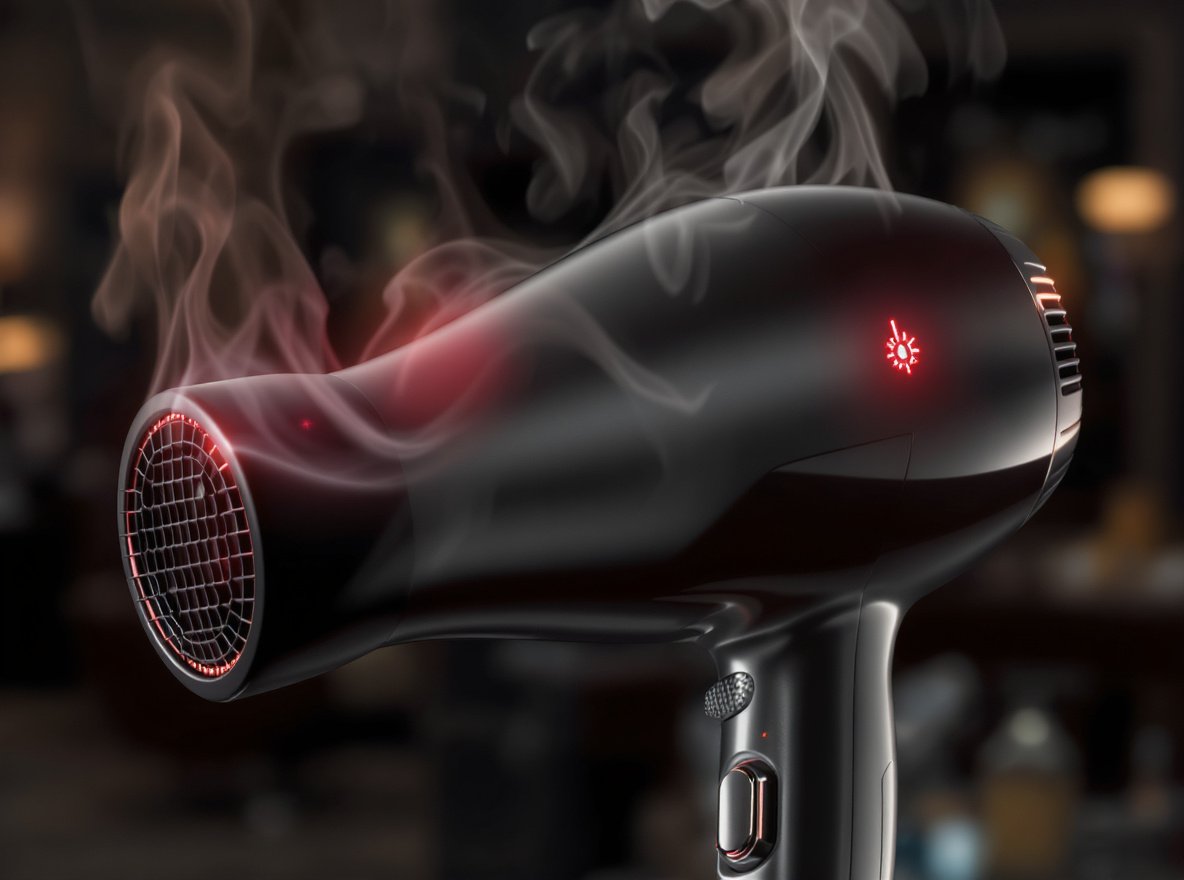Choosing between a high-speed and traditional hair dryer can feel overwhelming when you’re standing in the store looking at price tags that vary by hundreds of dollars. You want faster drying time and healthier hair, but you’re not sure if the investment is worth it.
High-speed hair dryers use brushless motors that spin at 100,000+ RPM, producing airflow speeds up to 100 mph. They cut drying time in half, operate 10-15 decibels quieter than traditional dryers, and use ionic technology to reduce heat damage and frizz.
Let me break down everything you need to know to make the right choice for your hair and budget.
Table of Contents
ToggleWhat Makes a Hair Dryer “High-Speed”?
Understanding the advanced technology behind high-speed dryers helps explain their superior performance. The engineering represents a significant leap from traditional hair dryer design.
High-speed dryers use brushless (BL) or electronically commutated (EC) motors that operate at 100,000-110,000 RPM, producing concentrated airflow up to 100 mph. They feature ionic technology that emits negative ions to break down water molecules, speeding drying while reducing frizz.
The brushless motor design eliminates physical friction between moving parts, allowing for much faster rotation speeds. This creates powerful, concentrated airflow that literally blows water away from hair strands rather than just evaporating it with heat.
Advanced fan designs and aerodynamic engineering focus the airflow into precise streams. Many models include multiple attachments like concentrators and diffusers that work with this powerful airflow for versatile styling options.
Ionic technology is a key differentiator. The negative ions break down water molecules into smaller particles that evaporate faster, while also smoothing the hair cuticle to reduce frizz and enhance shine.
How Do Traditional Hair Dryers Work?
Traditional hair dryers use simpler technology that’s been largely unchanged for decades. Most people are familiar with these conventional models that rely primarily on heat for drying.
Traditional dryers use AC or DC motors with brush-based systems that drive fans over heating elements (coiled wires). They typically operate at 3,000-20,000 RPM, producing lower airflow speeds and relying heavily on heat to evaporate moisture from hair.
AC motors are more powerful and durable, lasting around 2,000 hours of use. They’re preferred in professional settings because of their reliability and consistent performance, though they’re heavier and more expensive.
DC motors are lighter and more affordable, making them common in home models. However, they typically last only about 1,200 hours and provide less airflow than AC versions.
Both motor types use physical brushes that create friction against the motor components. This friction generates heat and limits maximum rotation speed, which is why traditional dryers often become very hot during extended use.
The heating elements in traditional dryers can create uneven heat distribution, leading to hot spots that may damage hair over time. Heat distribution varies significantly across different price points and brands.
What’s the Real Difference in Drying Time?
Drying time is often the most noticeable difference between dryer types. The time savings can be dramatic, especially for people with thick or long hair.
High-speed dryers cut drying time roughly in half compared to traditional models. Hair that takes 20-30 minutes with a traditional dryer can often be dried in 10-15 minutes with a high-speed model due to superior airflow and better heat distribution.
Here’s a detailed comparison of typical drying times:
| Hair Length & Thickness | Traditional Dryer | High-Speed Dryer | Time Saved |
|---|---|---|---|
| Short, Fine Hair | 5-8 minutes | 3-5 minutes | 2-3 minutes |
| Medium, Normal Hair | 10-15 minutes | 5-8 minutes | 5-7 minutes |
| Long, Thick Hair | 20-30 minutes | 10-15 minutes | 10-15 minutes |
| Curly, Coarse Hair | 25-35 minutes | 12-18 minutes | 13-17 minutes |
The dramatic time reduction comes from the powerful airflow that removes water through air movement rather than heat evaporation. This is particularly beneficial for thick, coarse, or long hair that traditionally takes the longest to dry.
Faster drying also means less arm fatigue and more time for other morning routines. For busy lifestyles, this time savings can be significant over weeks and months of daily use.
Are High-Speed Dryers Really Better for Hair Health?
Hair health is a crucial consideration when choosing any heat styling tool. The drying method significantly impacts your hair’s long-term condition and appearance.
High-speed dryers are significantly better for hair health because they reduce heat exposure time and often include advanced temperature sensors that adjust heat automatically. Many models monitor temperature up to 40 times per second to prevent overheating and hair damage.
Traditional dryers’ uneven heat distribution can cause several problems:
- Hot spots that damage hair cuticles
- Excessive heat exposure leading to dryness and breakage
- Increased frizz from damaged cuticle layers
- Dullness from repeated heat damage
High-speed dryers minimize these issues through:
- Lower heat dependency due to powerful airflow
- Automatic temperature regulation and sensors
- Ionic technology that smooths hair cuticles
- Reduced exposure time cutting damage risk in half
The ionic technology deserves special mention. Negative ions help seal the hair cuticle, reducing moisture loss and creating smoother, shinier hair. This technology is rarely found in traditional dryers but is standard in most high-speed models.
What About Noise Levels?
Noise is an important consideration, especially for early morning routines or shared living spaces. The motor technology significantly affects sound levels.
Traditional hair dryers typically produce 80-90 decibels, which can be uncomfortable with prolonged exposure. High-speed dryers with brushless motors operate 10-15 decibels quieter by eliminating mechanical friction and using advanced fan blade designs.
The noise reduction in high-speed dryers comes from several engineering improvements:
- Brushless motors eliminate friction-based noise
- Advanced fan blade materials (plastic or ceramic) reduce turbulence
- Better motor housing and insulation
- Smoother airflow patterns that create less wind noise
While high-speed dryers still produce sound from airflow, the motor noise is significantly reduced. This makes them more comfortable for daily use and less disruptive to others in your home.
Some premium models focus specifically on quiet operation, achieving noise levels comparable to normal conversation rather than the loud whirring of traditional dryers.
How Much Do They Cost and Are They Worth It?
Price is often the primary consideration when choosing between dryer types. Understanding the value proposition helps justify the investment.
Traditional dryers cost $20-150, while high-speed models range from $100-400+. The higher cost reflects advanced motor technology, ionic systems, temperature sensors, and premium materials. For people with thick, long, or frizzy hair, the investment often pays off through time savings and hair health benefits.
Detailed cost breakdown:
| Dryer Category | Price Range | Key Features | Best For |
|---|---|---|---|
| Budget Traditional | $20-50 | Basic DC motor, few settings | Short hair, occasional use |
| Professional Traditional | $80-150 | AC motor, multiple settings | Regular use, salon work |
| Entry High-Speed | $100-200 | Basic brushless motor, ionic tech | Upgrade from traditional |
| Premium High-Speed | $250-400+ | Advanced sensors, multiple attachments | Daily use, all hair types |
Consider the cost per year of ownership. A $300 high-speed dryer that lasts 8 years costs $37.50 annually, while a $50 traditional dryer lasting 3 years costs $16.67 annually. However, the high-speed model saves significant time and provides better hair protection.
The investment makes most sense for people who dry their hair daily, have challenging hair types, or value time savings and hair health over initial cost savings.
Which Hair Types Benefit Most from High-Speed Dryers?
Different hair types respond differently to various drying technologies. Your specific hair characteristics should guide your decision.
Thick, coarse, long, or frizzy hair benefits most dramatically from high-speed dryers due to significant time savings and frizz reduction. Fine or damaged hair also benefits from gentler, faster drying, though care must be taken with heat and speed settings.
Hair type specific benefits:
Thick, Coarse Hair:
- Dramatic time reduction (up to 15 minutes saved)
- Better heat distribution prevents damage
- Powerful airflow penetrates dense hair effectively
Long Hair:
- Cuts drying time nearly in half
- Reduces arm fatigue from extended styling
- More even drying from roots to ends
Frizzy Hair:
- Ionic technology significantly reduces frizz
- Less heat exposure prevents additional damage
- Smoother results with enhanced shine
Fine or Damaged Hair:
- Gentler drying with adjustable settings
- Reduced heat exposure prevents further damage
- Faster drying minimizes manipulation time
People with very short hair may not see dramatic time savings, though they’ll still benefit from reduced heat damage and quieter operation.
What Features Should You Look For?
Understanding essential versus nice-to-have features helps you choose the right dryer within your budget. Some features are crucial for performance and safety.
Essential features include multiple heat and speed settings, cool shot button, ionic technology, and temperature sensors for automatic heat regulation. Look for brushless or EC motors, lightweight design, and included concentrator attachments for versatile styling.
Must-have features for any quality dryer:
- Variable heat and speed controls for customization
- Cool shot button to lock in styles and add shine
- Removable filter for easy cleaning and maintenance
- Concentrator nozzle for directed, precise airflow
- Automatic shut-off for safety
High-speed dryer specific features:
- Brushless (BL) or electronically commutated (EC) motors
- Ionic technology for frizz reduction
- Temperature sensors with automatic regulation
- Magnetic attachments for easy switching
- Multiple styling attachments (diffuser, wide-tooth concentrator)
- Lightweight, ergonomic design for comfortable use
Advanced features worth considering:
- Memory settings that recall your preferred heat/speed combinations
- LED indicators showing temperature and ionic activation
- Folding handles for travel convenience
- Professional-length cords (9+ feet) for salon use
Avoid dryers without variable controls, as different hair types require different settings. Temperature sensors are particularly important in high-speed models to prevent the powerful motors from overheating your hair.
Summary
High-speed dryers offer substantial advantages in drying time, hair health, noise levels, and user experience, justifying their higher cost for most users. Traditional dryers remain functional for basic needs but lack the advanced technologies that protect hair and save time. Consider your hair type, daily routine, and long-term hair health goals when making your investment.
Ready to upgrade your hair routine? Start with a mid-range high-speed model to experience the benefits of brushless motor technology and ionic drying without the premium price point.











